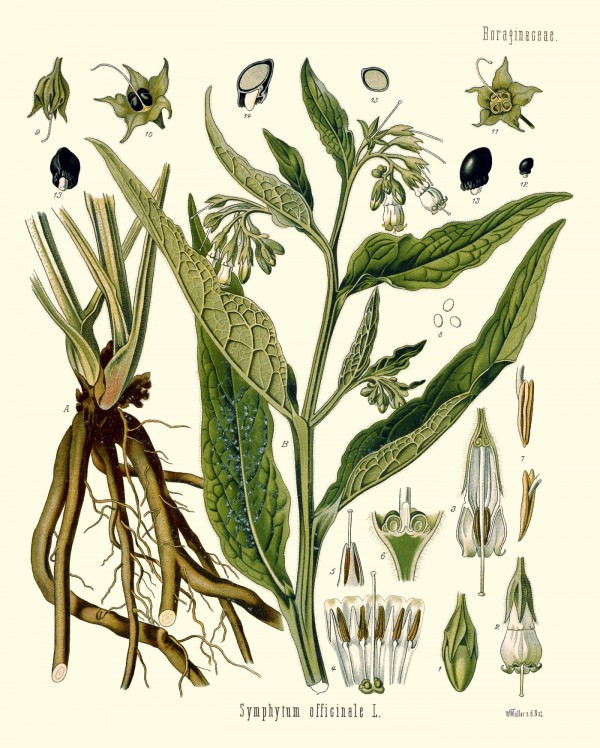Symphytum officinale L. - Boraginaceae - comfrey, Gemeiner Beinwell
Perennial herb, 0.30-1m high, native to Eurasia, introduced to North America; leaves large, hispid, broad lanceolate, ground leaves long petioled, others going up the stem with the base, forming wings; corolla tube reddish-violet or white, calyx nearly half as long as corolla.
„In dried leaves 0.02 to 0.18 and in the roots 0.25 to 0.29% alkaloids resp. their N-oxides were detected. The alkaloids include intermedine, lycopsamine, their 7-acetyl derivatives, symlandine, symviridine, myoscorpine, and symphytine. The presence of the alkaloids (echinatine, heliosupine N-oxide, heliotrine, lasiocarpine, and viridiflorine) isolated and characterized by a Russian and Polish working group by means of paper
chromatography could not be confirmed. A possible risk associated with the consumption of Symphytum in humans was repeatedly reported and in medical literature several cases of intoxication attributed to Smphytum and comfrey are described. In animal tests acute toxic effects were detected in rats and goats.“
[Medicinal plants in Europe containing pyrrolizidine alkaloids., Roeder, E., Pharmazie, Vol.50(2), 1995, 83-98]
„Since the pyrrolizidine alkaloids are known to be hepatotoxic, consumption of herbal teas made from comfrey leaves may be ill-advised. The concentration of pyrrolizidine alkaloids in such teas may be underestimated substantially unless the concentration of N-oxides is taken into consideration.“
[Analysis of herbal teas made from the leaves of comfrey (Symphytum officinale): reduction of N-oxides results in order of magnitude increases in the measurable concentration of pyrrolizidine alkaloids., Oberlies, N. H., Kim, N. C., Brine, D. R., Collins, B. J., Handy, R. W., Sparacino, C. M., Wall, M. E., Public health nutrition, Vol.7(07), 2004, 919-924]
„In the treatment of minor blunt injuries several topical drugs are known to have anti-inflammatory and analgesic properties. They represent, however, two fundamentally different major pharmacological therapy approaches: the “chemical-synthetical” and the “phytotherapeutical” approach. The main objective of this trial (CODEC_2004) was to compare the efficacy and tolerability of an ointment of Comfrey extract (Extr. Rad. Symphyti) with that of a Diclofenac gel in the treatment of acute unilateral ankle sprain (distortion)… It was confirmatorily shown that Comfrey extract is non-inferior to diclofenac. The 95% confidence interval for the AUC (Comfrey extract minus Diclofenac gel) was 19.01–103.09 h*N/cm2 and was completely above the margin of non-inferiority. Moreover, the results of the primary and secondary variables indicate that Comfrey extract may be superior to Diclofenac gel.“
[Efficacy of a Comfrey root extract ointment in comparison to a Diclofenac gel in the treatment of ankle distortions: Results of an observer-blind, randomized, multicenter study. Predel, H. G., Giannetti, B., Koll, R., Bulitta, M., Staiger, C., Phytomedicine, Vol.12(10), 2005, 707-714]
„The objective was to show the superiority of Comfrey root extract ointment (Kytta-Salbe® f; Merck Selbstmedikation GmbH) to placebo ointment in patients with acute upper or low back pain… Comfrey root extract showed a remarkably potent and clical relevant effect in reducing acute back pain. For the first time, also a fast acting effect of the ointment (1 hour) has been witnessed.“
[Efficacy and safety of comfrey root extract ointment in the treatment of acute upper or lower back pain: results of a double-blind, randomised, placebo controlled, multicentre trial. Giannetti, B. M., Staiger, C., Bulitta, M., Predel, H. G., British journal of sports medicine, Vol.44(9), 2010, 637]
„The key activity-determining constituents of comfrey root extracts and its molecular mechanisms of action have not been completely elucidated. Allantoin and rosmarinic acid are probably of central importance for its pharmacodynamic effects. The German Commission E has assessed Symphyti radix (comfrey root) deriving from Symphytum officinale L. positively for the external use in bruises, strains and sprains and acknowledged its actions as anti-inflammatory, antimitotic and promotion of callus formation.“
[Comfrey root: from tradition to modern clinical trials. Staiger, Christiane. Wiener Medizinische Wochenschrift 163.3-4, 2013, 58-64] http://link.springer.com/article/10.1007/s10354-012-0162-4/fulltext.html
The European Scientific Cooperative on Phytotherapy Monograph (ESCOP) on comfrey mentions strains, contusions and distortions, osteoarthritis (OA), epicondylitis, tendovaginitis and periarthritis as therapeutic indications substantiated by clinical trials.
[European Scientific Cooperative on Phytotherapy (ESCOP). Symphyti radix, Comfrey root. In: ESCOP, editor. ESCOP monographs: the scientific foundation for herbal medicinal products. 2nd ed. Suppl. Stuttgart: Thieme Verlag; 2009, 249–254]

Köhler, F.E., Medizinal Pflanzen, vol.1 t.40 (1887) [W.Müller]
http://www.plantillustrations.org/species.php?id_species=989234
